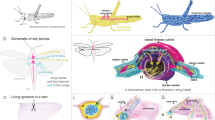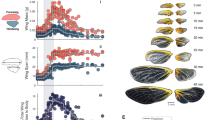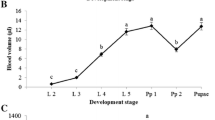Summary
The flow of stained haemolymph was photographed in the wings of resting Pieris rapae, Pieris brassicae, and Gonepteryx rhamni under UV-radiation at definite intervals after abdominal application of fluorescent tetracycline. There is no circular route in the wing. All wing veins are supplied with stained haemolymph from their own bases without preference to single veins. In freely resting Pieris with intact wings, most veins are completely stained after 20 min. The staining pattern supports the existence of an oscillating haemolymph supply mechanism in the wing veins and shows that the cross vein and encircling sinus are not essential in the supply of the longitudinal veins. Inflow of stained haemolymph into the wing membrane begins about 1 h after application and is generally completed within 12 h in Pieris. The wing membrane is supplied with fluid by diffusion and — especially under low relative humidity — additionally by haemolymph substitution of evaporated water.
This mechanism is associated with the disadvantages of water loss and probably salt withdrawal from the body. The puddling behaviour of butterflies might help in restoring these postulated deficits. It is hypothesized that haemolymph substitution of water evaporated from the wing membrane is a preadaptation for accumulation of defensive toxins and pheromones in the wing membranes, especially in diurnal and basking Lepidoptera.
The veinal system of 5-day-old young summer specimens of Gonepteryx stains more intensely than that of 4–5-month-old specimens just before entering hibernation. The transition of stained haemolymph from vein to membrane is reduced in this species, probably as an adaptation for water retention during diapauses.
Similar content being viewed by others
References
Arms K, Feeny P, Lederhouse RC (1974) Sodium: Stimulus for puddling behavior by tiger swallowtail butterflies, Papilio glaucus. Science 185:372–374
Arnold JW (1964) Blood circulation in insect wings. Mem Entomol Soc Can 38:1–60
Boppré M, Petty RL, Schneider D, Meinwald J (1978) Behaviorally mediated contacts between scent organs: Another prerequisite for pheromone production in Danaus chrysippus males (Lepidoptera). J Comp Physiol 126:97–103
Brower LP, Glazier CG (1975) Localization of heart poisons in the monarch butterfly. Science 188:19–25
Downes JA (1973) Lepidoptera feeding at puddle-margins, dung, and carrion. J Lepid Soc 27:89–99
Edgar JA, Boppré M, Schneider D (1979) Pyrrolizidine alkaloid storage in African and Austrlian danaid butterflies. Experientia 35:1447–1448
Hering EM (1926) Die Biologie der Schmetterlinge. Biologische Studienbücher. Springer, Berlin, pp 1–40
Kolyer JM (1973) Vital staining as evidence for wing circulation in the cabbage butterfly Pieris rapae. J Res Lepid 11:161–173
Lüdicke M (1952) Über die Aufnahme von radioaktivem, sekundärem Natriumphosphat bei Lucanus cervus L. Z vergl Physiol 34:508–524
Märkel K (1975) Wachstum des Coronarskeletes von Paracentrotus lividus Lmk. (Echinodermata, Echinoidea). Zoomorphologie 82:259–280
Müller F (1877) Ueber Haarpinsel, Filzflecke und ähnliche Gebilde auf den Flügeln männlicher Schmetterlinge. Jena Z Naturw 11:99–114
Münchberg P (1966) Zum Bau der Libellenflügel und nochmals zur Illustration ihrer Durchblutung durch Injektion von Na2 35SO4. Dtsch Ent Z (NF) 13:383–391
Nicolson SW (1976) Diuresis in the cabbage white butterfly, Pieris brassicae: Fluid secretion by the malpighian tubules. J Insect Physiol 22:1347–1356
Pliske TE (1975) Attraction of Lepidoptera to plants containing pyrrolizidine alkaloids. Environ Ent 4:455–473
Portier P (1949) La Biologie des Lépidoptères. Encyclopédie Entomologique, Lechevalier, Paris, pp 1–643
Reichelt M (1925) Schuppenentwicklung und Pigmentbildung auf den Flügeln von Lymantria dispar unter besonderer Berücksichtigung des sexuellen Dimorphismus. Z Morph Ökol Ontog Tiere 3:477–525
Schneider D, Boppré M, Schneider H, Thompson WR, Boriack CJ, Petty RL, Meinwald J (1975) A pheromone precursor and its uptake in male Danaus butterflies. J Comp Physiol 97:245–256
Shapiro AM (1977) Phenotypic induction in Pieris napi L.: role of temperature and photoperiod in a coastal California population. Ecol Entomol 2:217–224
Wasserthal LT (1975) The role of butterfly wings in regulation of body temperature. J Insect Physiol 21:1921–1930
Wasserthal LT (1980) Oscillating haemolymph ‘circulation’ in the butterfly Papilio machaon L. revealed by contact thermography and photocell measurements. J Comp Physiol 139:145–163
Wasserthal LT (1982) Antagonism between haemolymph transport and tracheal ventilation in an insect wing (Attacus atlas L.). J Comp Physiol 147:27–40
Author information
Authors and Affiliations
Rights and permissions
About this article
Cite this article
Wasserthal, L.T. Haemolymph flows in the wings of pierid butterflies visualized by vital staining (insecta, lepidoptera). Zoomorphology 103, 177–192 (1983). https://doi.org/10.1007/BF00310476
Received:
Issue Date:
DOI: https://doi.org/10.1007/BF00310476




